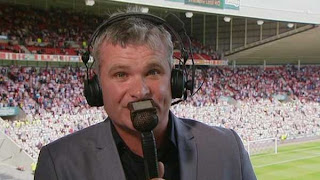 |
| One of the boxes at the Indian F1 Circuit |
Aside from telling the story of an event, it is a very
important responsibility to try and bring the audience to the venue, to make
them feel involved. That may sound like a bit of a wishy-washy arts graduate
opinion, but it’s what I attempt to do. Off-tube commentary for example – where
the commentator is hundreds of miles from an event, commentating from a TV
studio – will never be as good as that same commentator working on-site in my opinion. Often the audience wouldn't be able to tell the difference, but I much prefer working at the event. Facilities like those in India, though, are pretty much off-tube rooms that
happen to be on-site. But not only would I like
to see the end of commentary boxes in stupid positions, or with limited views
of any aspect of the circuit, I’d like to do away with commentary boxes all
together.
Football commentary doesn’t come from boxes. The
commentators are sat in the crowd, with the best view in the house, but why?
They too are just commentating on the TV pictures from the monitor in front of
them. So the argument becomes that it helps them bring the atmosphere to the
viewers. I love football, but atmosphere essentially consists of grown men
shouting and insulting each other like children. You can’t hear the players
talking to each other, can’t see the nuances that the TV cameras may have
failed to pick up, all you get is chanting.
 |
| Guy Mowbray's commentary position at a football ground |
What got me thinking about all this was last weekend in
Dubai. I was out there commentating on the XCAT Powerboat World Series for the
first time, and instead of a box I was plonked on the race control boat, open
to the elements save for a canopy above my head on the top deck of this yacht,
perhaps 50 metres from the finish line where the boats were skimming over the waves at
120mph. Suddenly, you’re involved. You’re there. The boat is rocking as each
powerboat speeds past, you can hear the sound, smell the oil and see the
drivers working the wheel. It invigorates you and excites you, and as a result
allows you to better communicate the spectacle to the viewers. It was
fantastic. We all know how intoxicating it is watching motorsport, so why
should we be excluded from that environment whilst trying to convey it to our
audience?
 |
| Powerboat commentary position in Dubai |
 |
| Which made me a happy chappy |
Motorsport is the most spectacular of sports. My job is
brilliant. But being locked up in a small sterile room is the worst part of it,
and doesn’t provide the right environment for good commentary. If I'm commentating at Cadwell Park in Lincolnshire, I will often take the microphone outside of the box and sit on the grass bank outside. Murray Walker
apparently commentated from the pitlane at Monaco in the 1980s, what an
absolute thrill that must have been. Noise may be an issue, but frankly
technology is advanced enough for that not to be a particular stumbling block. I'd love to commentate from in the grandstand with the fans, just like football commentary, and I think
it would create a better environment for my work.











